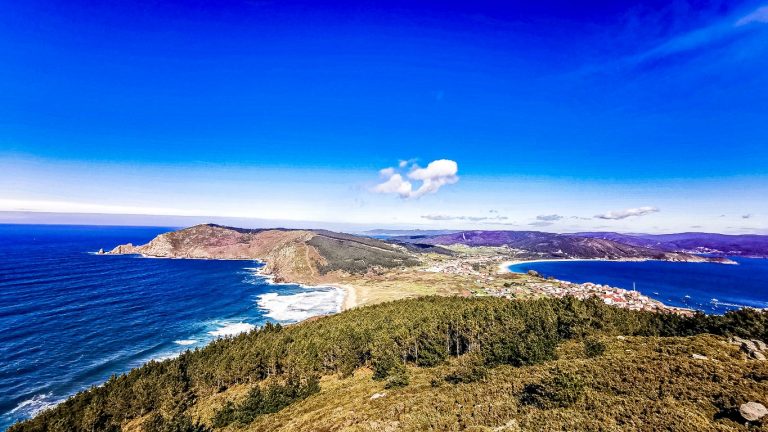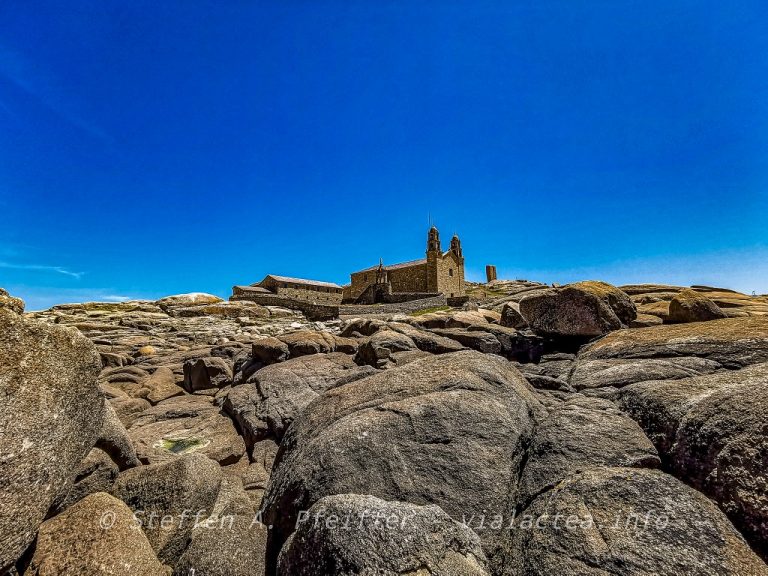
The Camino Francés, also known as the French Way, spans an impressive distance of around 800 kilometers. This historic pilgrimage route begins in Saint-Jean-Pied-de-Port, a charming French town in the Pyrenees, and ends in Santiago de Compostela, the resting place of the Apostle James. The entire route can be completed on foot in about 30 to 35 days, although many pilgrims choose to walk shorter sections depending on their available time and physical condition.
Length, Duration, and Stages
The route is traditionally divided into 31 stages, with daily distances varying between 18 and 30 kilometers. Notable stops along the way include Pamplona, Burgos, León, and finally Santiago de Compostela. Each stage offers a unique blend of cultural, historical, and scenic highlights, from the majestic Pyrenees and the vast plains of the Meseta to the verdant hills of Galicia.
The Camino Francés stretches over approximately 800 kilometers and is divided into 31 stages, each differing in length and character. This structure allows pilgrims to tailor their journey, whether by walking the entire route or selecting specific sections. Each stage is like a chapter in a grand adventure, narrated through history, nature, and culture.
The total duration of the journey depends on individual pace, but it generally takes around 30 to 35 days. For beginners or pilgrims with limited time, the section from Sarria to Santiago, covering the last 100 kilometers, is a popular alternative as it can be completed in about five days and meets the requirements for earning the “Compostela.”

The Pyrenees and Navarra
The first stage from Saint-Jean-Pied-de-Port to Roncesvalles is considered one of the most challenging. With an elevation gain of over 1,250 meters, this stage demands both physical strength and endurance but rewards pilgrims with breathtaking views of the Pyrenees and the sense of crossing a natural border. Alternatively, the “Valcarlos Route” offers a less steep but equally picturesque alternative. Between November 1 and March 31 of the following year, when the “Napoleon Route” is closed, the “Valcarlos Route” is the only way to reach Roncesvalles.
Warning! During this period, the snowy conditions in the Pyrenees and on the pass route result in a closure for safety reasons. Anyone who attempts to take this route risks a minimum fine of around 6,000 euros, plus additional rescue costs, which are not insurable as they are considered a deliberate act and must be paid directly.
From Roncesvalles to Pamplona, pilgrims traverse the picturesque Navarra region, known for its dense forests, charming villages, and the renowned “Alto de Mezkiritz.” Pamplona, the first major city along the way, offers a fascinating blend of medieval architecture and vibrant atmosphere.

La Rioja and the Meseta
After crossing the elegant medieval bridge at Puente la Reina, the route enters the La Rioja region. Here, pilgrims wander through endless vineyards and pass historic towns such as Logroño, Nájera, and Santo Domingo de la Calzada, famous for the legend of the “singing hen.” These stages are filled with moments of indulgence, from Rioja wine to local culinary delights.
Further west, pilgrims enter the Meseta, a vast plateau stretching from Burgos to León. These stages are notorious for their monotony but also offer tranquility and opportunities for reflection. Cities like Burgos, with its Gothic cathedral, and León, with the impressive Basilica of San Isidoro, provide cultural highlights that reward the effort.

From León to El Bierzo: Mountains, History, and Spiritual Milestones
After León, one of the cultural hubs of the Camino Francés, the route ascends into the mountainous landscapes of Astorga and the historic region of El Bierzo. Astorga impresses with its Roman heritage, the imposing cathedral, and the episcopal palace designed by Antoni Gaudí, an architectural masterpiece combining Neo-Gothic and modernist elements. From here, the Camino transforms: the gentle plains of the Meseta give way to the dramatic climbs of the Montes de León, with their pinnacle at the “Cruz de Ferro.” Here, pilgrims place stones or personal items, a symbolic act of shedding burdens and making space for new beginnings.
Descending into El Bierzo, a fertile valley known for its Mencía wine, lush vineyards, and picturesque villages, pilgrims reach Ponferrada, the region’s largest city, renowned for its impressive Templar castle, offering a historic glimpse into medieval pilgrimage. The journey continues to Villafranca del Bierzo, a town steeped in history, where, during the Middle Ages, pilgrims unable to proceed to Santiago could receive their final blessing at the Church of Santiago, symbolically completing their pilgrimage. This deep connection to the Camino’s history makes Villafranca an essential stop.
From Villafranca, the gradual yet challenging ascent to O Cebreiro begins. This small Galician village, with its characteristic “Pallozas” – traditional stone roundhouses – serves as the gateway to Galicia and a spiritual cornerstone of the Camino. Renowned for the “Eucharistic Miracle” and its stunning views of the surrounding mountains, O Cebreiro invites pilgrims to pause and reflect on the profound symbolism of their journey.

Galicia
The final stages of the Camino Francés through Galicia offer a welcome change. The landscape transitions from rolling hills to lush green valleys, accompanied by a mild, humid climate. From Sarria, approximately 100 kilometers before Santiago, the route becomes noticeably busier as many pilgrims begin their journey here to qualify for the “Compostela.” The stages through charming villages such as Portomarín, Palas de Rei, and Arzúa bring pilgrims ever closer to their goal.

Arrival in Santiago de Compostela and Beyond
Arriving in Santiago de Compostela is the pinnacle of any pilgrimage on the Camino Francés. The magnificent cathedral, with its grand Baroque altar and the Botafumeiro – the famous incense burner – welcomes pilgrims from around the world. In Holy Years, such as the upcoming 2027, pilgrims have the unique opportunity to walk through the “Holy Door” (Porta Santa) and receive forgiveness of their sins – a spiritual moment of extraordinary significance.
For many, however, the journey does not end here. Many pilgrims choose to continue their steps – to the “end of the world.” The route extends from Santiago to Fisterra (Cape Finisterre) and Muxía, or in reverse via Dumbría to Fisterra. The Costa da Morte, the “Coast of Death,” is renowned not only for its breathtaking sunsets but also for its profound symbolism: the place where the earthly end meets the infinite horizon. It is a place of reflection and farewell – from the journey, from burdens, and perhaps from old patterns of thought.

Difficulty
The difficulty of the Camino Francés varies depending on the stage. Crossing the Pyrenees is considered particularly challenging, as is the ascent to O Cebreiro in Galicia. On the other hand, the flat sections of the Meseta provide physical relief but require mental strength due to the monotonous landscape. Overall, however, the route is described as accessible for pilgrims of all experience levels, provided they prepare well and walk at their own pace.

Uniqueness of the Stages and the Camino Francés as a Whole
Each stage tells its own story. Whether it is the spiritual symbolism of the “Cruz de Ferro” at the highest point of the route, the historical allure of the Templar castle in Ponferrada, or the picturesque beauty of the ascent to O Cebreiro – each stage adds a distinctive facet to the Camino.
Together, the stages of the Camino Francés form a fascinating journey that combines physical challenges with cultural depth and spiritual significance. Whether one walks the entire route or selects individual sections, the Camino offers unforgettable experiences for every pilgrim.
In future articles, I will delve deeper into these impressive extensions of the pilgrimage route. From the best stage plans to historical facts and spiritual inspirations – there are still many stories waiting to be told. The Camino never truly ends; it always takes us further, step by step.

Best Time to Travel
The ideal time to travel is in spring (April to June) and autumn (September to October). During these months, temperatures are moderate, and accommodations are less crowded than in the summer months. Winter pilgrims should be aware that some sections, particularly in the Pyrenees, may not be accessible due to snow or adverse weather conditions. The Camino Francés is not just a physical challenge but also a unique opportunity to immerse oneself in the cultural and spiritual history of Spain. With its well-developed infrastructure, numerous accommodations, and diverse scenic impressions, it is the most popular choice among pilgrims worldwide.


